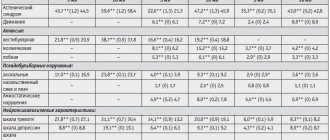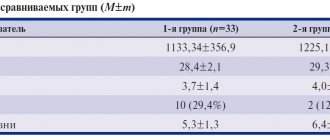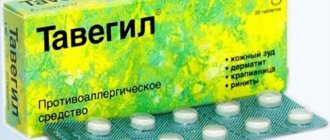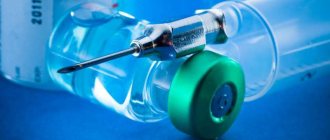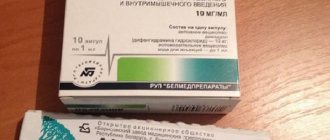Compound
Active components of the injection solution Combilipen:
- Vitamin B6 (Pyridoxine hydrochloride)
- Vitamin B1 (Thiamin hydrochloride)
- lidocaine hydrochloride
- Vitamin 12
Excipients of the drug:
- potassium hexacyanoferrate
- sodium tripolyphosphate
- purified water
- benzyl alcohol
Active components of tablet form:
- benfotiamine
- pyridoxine hydrochloride
- cyanocobalamin
Additional substances:
- microcrystalline cellulose
- carmellose sodium
- Povidone K30
- sucrose
special instructions
During the therapeutic course, you should not simultaneously take other multivitamin complexes that contain B vitamins.
If injections or tablets are taken together with Levodopa, the effect of vitamin B6 on the human body is significantly reduced.
Before starting treatment, you need to consult a specialist. If treatment is carried out with Combilipen, then it is best to refrain from driving a vehicle and other dangerous mechanisms for the first time after taking it.
pharmachologic effect
The drug is a multivitamin complex, among the components there are several components:
- Vitamin B1 (thiamine hydrochloride) provides the necessary amount of glucose to nerve cells. Glucose deficiency provokes deformation and enlargement of nerve cells, which causes disruption of their functions.
- Vitamin B6 (pyridoxine hydrochloride) is a direct participant in the metabolic processes of the central nervous system
- Vitamin B 12 is involved in the combination of myelin, folic acid, nucleic acids
Analogs
It is difficult to talk about the originality of certain drugs when we are talking about complex vitamin preparations for various reasons (in particular, different doses of the drug, the use of different solvents, etc.). Analogues are such drugs as CompligamV, Vitaxon, Milgamma, Vitagamma in the form of a solution.
Indications for use of Kombilipen
A multivitamin complex is prescribed for a number of neurological diseases:
- inflammation of the facial nerve
- trigeminal neuralgia
- diabetic or alcoholic polyneuropathy
- pain associated with spinal disease
The use of Combilipen leads to better results when used in complex therapy.
Side effects
Side effects may include itching, urticaria, difficulty breathing, and more serious effects may include the development of Quincke's edema and anaphylactic shock. Occasionally, acne, rash, sweating, and tachycardia may appear.
Overdose
Symptoms of an overdose may include nausea and vomiting, itching and urticaria, dizziness, severe sweating, and tachycardia.
Recommended treatment is symptomatic therapy.
How much to inject Combilipen
Injection solutions are intended for intramuscular administration. For pronounced symptoms of the disease, injections of 2 ml of the drug are given every day for 7 days. After the administration of the medication, it is necessary to continue for another 2 weeks, only during this time injections are given only 2-3 times a week.
A mild form of the disease involves injection 2 or 3 times a week for 10 days.
The treatment course using the Kombilipen injection solution should be carried out for no more than 14 days. The dosage must be adjusted by a specialist.
Combilipen®
Thiamine
After intramuscular administration, thiamine is quickly absorbed from the injection site and enters the blood (484 ng/ml after 15 minutes on the first day of administration of a 50 mg dose) and is unevenly distributed in the body with its content in leukocytes 15%, erythrocytes 75% and in blood plasma 10 %. Due to the lack of significant reserves of the vitamin in the body, it must be supplied to the body daily.
Thiamine penetrates the blood-brain and placental barriers and is found in breast milk. Thiamine is excreted by the kidneys in the alpha phase after 0.15 hours, in the beta phase after 1 hour, and in the final (terminal) phase within 2 days. The main metabolites are: thiaminecarboxylic acid, pyramine and some unknown metabolites. Of all the vitamins, thiamine is stored in the body in the smallest quantities. The adult human body contains about 30 mg of thiamine: 80% in the form of thiamine pyrophosphate. 10% in the form of thiamine triphosphate and the rest in the form of thiamine monophosphate.
Pyridoxine
After intramuscular injection, pyridoxine is quickly absorbed from the injection site and distributed in the body, acting as a coenzyme after phosphorylation of the CH2OH group at the 5th position. About 80% of the vitamin binds to blood plasma proteins. Pyridoxine is distributed throughout the body, penetrates the placenta, and is found in breast milk. It accumulates in the liver and is oxidized to 4-pyridoxic acid, which is excreted by the kidneys within a maximum of 2-5 hours after absorption.
The human body contains 40-150 mg of vitamin B6 and its daily elimination rate is about 1.7-3.6 mg with a replacement rate of 2.2-2.4%.
Cyanocobalamin
Cyanocobalamin, after intramuscular administration, binds to transcobalamins I and II and is transported to various tissues of the body. The maximum concentration after intramuscular administration is achieved after 1 hour. Communication with blood plasma proteins - 90%. Penetrates the placental barrier and is found in breast milk. Metabolized primarily in the liver to form adenosylcobalamin, which is the active form of cyanocobalamin. It is deposited in the liver, enters the intestines with bile and is reabsorbed into the blood (the phenomenon of enterohepatic recirculation).
The half-life is long, excreted mainly by the kidneys (7-10%) and through the intestines (50%). With a decrease in renal function, 0-7% is excreted by the kidneys and 70-100% through the intestines.
Lidocaine
When administered intramuscularly, the maximum plasma concentration of lidocaine is observed 5-15 minutes after injection. Depending on the dose, about 60-80% of lidocaine is bound to plasma proteins. Quickly distributed (within 6-9 minutes) in organs and tissues with good perfusion, incl. heart, lungs, liver, kidneys, then in muscle and adipose tissue. Penetrates the blood-brain and placental barriers and is found in breast milk (up to 40% of the concentration in the mother's blood plasma).
Metabolized in the liver with the participation of microsomal enzymes with the formation of active metabolites - monoethylglycine xylide and glycine xylide. having a half-life of 2 and 10 hours, respectively. Metabolic intensity decreases in liver diseases. It is excreted mainly in the form of metabolites by the kidneys and up to 10% unchanged.
Overdose and its dangers
When using large dosages, the symptoms of the negative effects of the drug intensify.
Signs of overdose:
- dizziness
- tachycardia
- allergic reaction
- nausea, vomiting
If you have symptoms of overdose, you should:
- perform gastric lavage
- carry out symptomatic therapy
- take activated charcoal
Indications
Combilipen is part of a complex treatment for trigeminal neuralgia, as well as for neuritis of the facial nerve.
It is used in the presence of pain syndrome arising from diseases of the spine (lumboischialgia, intercostal neuralgia, lumbar, cervical and cervicobrachial syndromes, as well as radicular syndrome, which was caused by degenerative changes in the vertebrae).
It can be prescribed for various polyneuropathies, for example, alcoholic or diabetic.
Therapeutic effect
The B vitamins included in the injections are neurotropic. They have a beneficial effect on the condition of the nerve endings of the spinal cord and brain. In particular, vitamin B1 accelerates the conduction of nerve impulses along fibers in tissues of different structures. Paralysis and paresis are also indications for the use of Combilipen.
Pyridoxine
necessary for complete metabolism, hematopoiesis, and the action of the central and peripheral nervous system. It is actively involved in the stimulation of synapses (fiber connection points) and the synthesis of sphingosine. And vitamin B12 is indispensable for the formation of new cells in various tissues and organs. Cyanocobalamin is a catalyst in the process of synthesis of nucleotides that make up DNA.
Thanks to this “bouquet” of useful substances, the drug has a number of therapeutic effects:
- accelerates the restoration of the sheath of nerve fibers and specific elements of nervous tissue;
- increases the production of neurotransmitters - substances necessary to control inhibition and excitation in the central nervous system;
- normalizes metabolism;
- helps the body resist the negative external environment;
- accelerates the regeneration of nerve cells.
WE RECOMMEND THE ARTICLE!
Vitamin C stimulates the body and improves the performance of the autoimmune system. Read more >>
Unlike Combilipen Tabs tablets, injections are widely prescribed to eliminate moderate pain.

This action is due to the presence of lidocaine in the composition.
The peculiarity of this product is that all trace elements are contained in very high dosages.
Interaction with other drugs
Despite the fact that Combilipen is a vitamin-containing product, it is incompatible with a wide range of medications. The drug is not prescribed together with Levodopa, as it reduces the absorption of the solution. And lidocaine, which is contained in injections, neutralizes the effect of Levodopa.
Drinking alcohol while using Kombipilen sharply reduces its effectiveness.
You cannot prescribe the medicine with the following drugs:
- Mercury acetate, chloride, carbonate and iodide;
- Phenobarbital sodium;
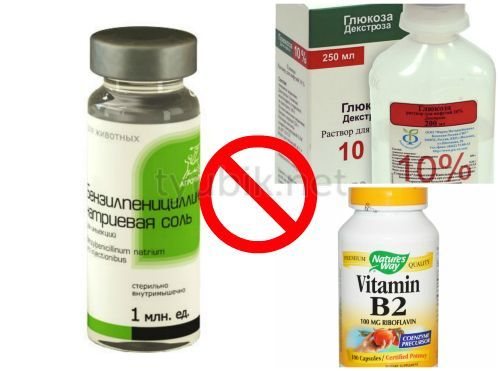
- Tannic acid;
- Vitamin B2 (riboflavin);
- Benzylpenicillin;
- Dextrose;
- Metabisulfite.
The injections are incompatible with salts of heavy metals and vitamin C. It is strictly forbidden to take the drug together with any vitamin complexes, adrenaline and norepinephrine. This combination will cause interruptions in the heart rhythm, even to the point of cardiac arrest.
The active ingredients are completely decomposed by sulfites. Therefore, it is not advisable to prescribe the drug with injectable forms of Tetracycline, Doxycycline, Oxytetracycline and Minocycline.
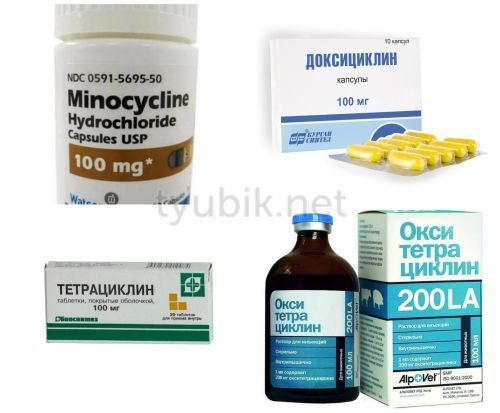
Contraindications
Due to the fact that the useful elements in Kombilipen are contained in the “shock”, it is not advisable to take it:
- patients who have a tendency to develop thrombosis;
- children under 18 years of age;
- during pregnancy and lactation;
- people with heart failure;
- suffering from Parkinson's disease.
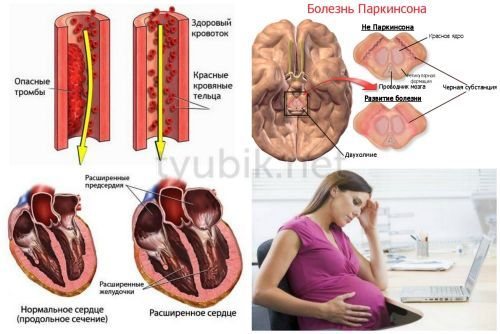
The drug is strictly contraindicated if there is an individual intolerance to any of the components. Caution should be exercised when prescribing the drug to patients with cancer, hepatitis, diabetes mellitus and serious nervous disorders.
